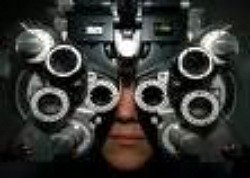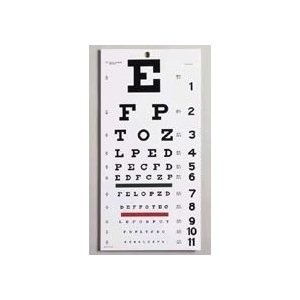|
Eye Refraction Exam
Do you have trouble identifying faces at a distance? Do you have trouble reading small print at near? Do you have difficulty seeing at all distances? You need an Eye Exam, which will include an Eye Refraction Exam…let’s look closer. An Eye Refraction Exam…let’s look closer

An Eye Refraction Exam involves the use of the above instrument called the Phoropter. This instrument has dials and knobs that your eye doctor can spin and move in order change the lenses you see through and thus check for such refractive errors and Eye Problems as:
Your eye doctor will place the Phoropter in front of your face and plug in a prescription in the instrument as a starting point. This starting point can be found any number of ways: Your eye doctor will move the instrument back and forth side to side while adding lenses until the beam of light stops moving. This finding can then serve as an accurate starting point for refining your prescription. The Refraction Exam will then involve many choices provided by your eye doctor in the effort to refine and fine-tune your eyeglasses prescription. Your eye doctor will probably isolate a line of letters (or other figures) on an Eye Test Chart for you to look at during this part of the Eye Exam. First, your eye doctor will find the spherical component of your prescription. During this part of the Eye Exam, your eye doctor will add or take away either minus lenses (for Myopia) or plus lenses (for Hyperopia) until you see the clearest. Once the best spherical lens is found that gives you the clearest vision, your eye doctor may check for Astigmatism, if you have it. First, the axis will be fine-tuned by having you choose the clearer of two choices as your eye doctor spins the axis dial gradually. Once the axis of the Astigmatism is found, then your eye doctor will provide choices to fine-tune the power of the Astigmatism. Your vision should be considerably clearer than in the beginning of the exam after this portion of the Eye Refraction Exam. You will then have to read the smallest line of letters (or other figures) you see through the new prescription in the distance. Your eye doctor will document this visual acuity in the record along with the numbers of the prescription.
If you have difficulty reading at near and you are over 40, then you will be checked for a bifocal prescription. Your eye doctor will add magnifying plus lenses over your distance prescription until you can achieve 20/20 vision at near, or the best vision you can. Even if you are not over 40, you will be checked for focusing problems and may be prescribed bifocals to help you with near work. |





 But your Eye Refraction Exam does not end there. Your eye doctor will then have you read from a near Eye Test Chart through the new prescription.
But your Eye Refraction Exam does not end there. Your eye doctor will then have you read from a near Eye Test Chart through the new prescription.